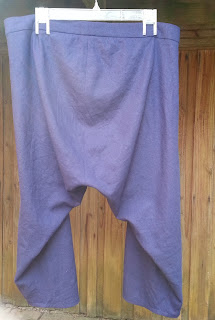I am so proud of myself. I sewed an ensemble, a complete outfit. It included a statement jacket with trim details like this Givenchy jacket currently available at Pert-A-Porter, a top with
the gathers and ruffles that are so on trend, and a pair of loose fitting cropped pants. Unfortunate it is not for me, but for a client that want to look like this for an event.
Yes, my client wanted a Captain Morgan costume. Captain Morgan being a brand of rum that features a rather dandified “pirate” on the label. But I did find similar coats on historic figures of the early 18th century
 |
| Wardrobe of Peter I Russia |
 |
| Admiral Edward Russell (1652–1727), |
The jacket is knee length with gores inserted at side and center back. The sleeves are shaped, and have gigantic cuffs.
 |
| Captain Morgan Jacket |
 |
| Captain Morgan Jacket side |
 |
| Captain Morgan Jacket trim detail |
 |
| Spray Painted Buttons |
The shirt was very loose fitting with gathers everywhere, neck edge, and on the sleeves at both shoulder and cuffs. The fabric for shirt was a 100% cotton twin size sheet. I purchase white cotton sheets, when they are on sale, for muslin, costumes and curtain linings. My client could not tie the collar closed on his 16” neck so he wore the shirt open. However the front slit is 14” deep which revealed a bit too much hairy man chest, so I tacked the slit closed for bottom 6”. The client could still pull shirt on over his head.
 |
| Shirt Simplicity 4923 |
The pants or breeches are calf length with authentic bagginess in the front and back crotch area, and buttons on lower side seams. The front closure is a flap that buttons to front waist band. Fabric used was a navy medium weight rayon/linen.
Captain Morgan also has a hat. Not a plain black pirate No, his is red with gold trim. A bit to matchy, matchy for my taste, but my client wanted it. Researching "make your own pirate hat" on the internet, I found the easiest ones started with a woman's brimmed hat. You cover them with felt or leather look material, and turn up and tacking the brim to the crown in three equal sections. I found the hat below in the sale bin at JoAnn's.
I attempted to spray paint the hat red, starting with the upper brim and crown. It looked like a spray-painted straw hat. Time was running out, so in the end we settled for a black brim with gold trim.
 |
| Captain Morgan Pirate Hat |
Boot covers were planned, but there was no time for them either so Captain Morgan wore tall leather work boots. My client was very happy. He got lots of compliments and requests for photo's.
 |
| Captain Morgan and swashbuckling sidekick |













